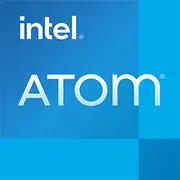Intel Atom N2800

Intel Atom N2800: Ultra-Budget Processor for Niche Tasks in 2025
Introduction
In an era where Apple M3 and Intel Core Ultra processors vie for the title of the most efficient, the Intel Atom N2800 appears to be a relic of the past. However, even in 2025, this chip finds its place in specific scenarios. Let’s explore who might benefit from this platform and for what purposes.
Architecture and Process: Minimum Transistors, Maximum Savings
Cores and Threads:
Launched in 2012, the Atom N2800 is built on the Saltwell architecture (codename Cedarview). It is a dual-core processor with Hyper-Threading support (4 threads), operating at a base frequency of 1.86 GHz. Turbo mode is absent, limiting peak performance.
Process Technology:
The 32nm technology looks archaic in 2025. In contrast, modern Intel processors utilize a 3nm process, reducing power consumption and enhancing transistor density. However, at its time, the 32nm technology allowed the Atom N2800 to achieve a TDP of just 7W.
Integrated Graphics:
The GPU depends on the motherboard chipset (most often, PowerVR SGX545). This solution supports DirectX 9 but has modest performance: even 1080p video playback is only feasible with hardware acceleration. It is unsuitable for gaming in the 2020s.
Power Consumption and TDP: Quieter Than Water, Lower Than Grass
TDP 7W:
The low thermal output allows for passive cooling. This makes devices using the Atom N2800 silent, but performance is constrained. Modern analogs (like the Intel N100 with TDP of 6W) are 3-4 times more powerful at similar power consumption.
Power-Saving Technologies:
- Intel SpeedStep — dynamic frequency adjustment based on load.
- C-states — reduced power consumption during idle times.
However, the lack of modern standards like the Adaptix Thermal Framework (used in Core Ultra) makes power management less flexible.
Performance: Modest Capabilities for Basic Tasks
Office Work:
- Web Surfing: A browser with 5-7 tabs (Chrome, Firefox) will operate with delays. It is advisable to use lightweight OS options (Linux Lite) or browsers (Falkon).
- Documents: LibreOffice, Google Docs — acceptable speed, but simultaneous work with PDFs and messaging apps may cause lags.
Multimedia:
- Video: Streaming 720p (YouTube) is possible; 1080p plays with interruptions. Local playback of 1080p depends on the codec (H.264 — yes, H.265 — no).
- Audio: Podcasts and music — no issues.
Gaming:
- Retro Games: DOSBox, emulators up to PS1.
- Modern Games: Minecraft (versions up to 1.12) on minimum settings — 10-15 FPS.
Geekbench 6:
- Single-Core: 88 — five times lower than the Intel N100 (450).
- Multi-Core: 214 — comparable to Raspberry Pi 4 (225), but weaker than budget smartphones.
Use Cases: Who Will Benefit from the Atom N2800 in 2025?
1. Educational Devices: Budget laptops for schools (for example, HP Stream 11) — new models priced at $150-$200.
2. Thin Clients: Terminals for working with cloud applications.
3. Mini-PCs for Digital Signage: Low power consumption and passive cooling.
4. Backup Devices: Laptops for travel where battery life is more critical than speed.
Not Suitable For:
- Video editing, programming, gaming.
- Running Windows 11 (requires TPM 2.0, which is absent).
Battery Life: Long but Slow
Usage Time:
A laptop with a 40Wh battery (like the Lenovo IdeaPad Slim 1N2800) can operate for 8-10 hours under minimal load. However, modern processors (AMD Mendocino) provide 6-8 hours with similar capacity but higher performance.
Energy-Saving Tips:
- Turn off Wi-Fi/Bluetooth.
- Use SSD instead of HDD.
- Reduce screen brightness.
Comparison with Competitors: Outdated but Cheap
1. AMD A4-9120 (2019):
- 2 cores, TDP 10-15W.
- Geekbench 6 SC: 250, MC: 450.
- Device price: $250-$300.
2. Intel N100 (2023):
- 4 cores, TDP 6W.
- Geekbench 6 SC: 450, MC: 1300.
- Price: $300-$400.
3. Apple M1 (2020):
- An indirect competitor, but shows a performance gap (SC: 2300, MC: 8300).
Conclusion: The Atom N2800 falls short even against budget modern chips, but it wins on price.
Pros and Cons
Strengths:
- Device cost ($150-$200).
- Passive cooling.
- Linux compatibility.
Weaknesses:
- Low performance.
- Lack of support for Windows 11.
- Limited compatibility with modern software.
Laptop Selection Recommendations
1. Device Type: Ultra-budget laptop or mini-PC.
2. What to Check:
- Presence of SSD (at least 128GB).
- 4GB RAM (preferably with upgrade options).
- Ports: USB 3.0, HDMI.
3. OS: Linux (Lubuntu, Xubuntu) or Windows 10 LTSC.
Example Model from 2025:
- Acer Aspire N2800 Edition — 11.6" screen, 4GB RAM, 128GB SSD, priced at $170.
Final Conclusion: Who Is This Processor For?
The Intel Atom N2800 is suitable for those seeking:
- An extremely cheap device for text-based tasks.
- An energy-efficient terminal for specific tasks.
- A backup laptop with long battery life.
Key Benefits:
- Price below $200.
- Silent operation.
- Compatibility with lightweight OS.
Alternative: If the budget allows $300, opt for devices with Intel N100 or AMD Mendocino — they will offer more growth potential.
The Atom N2800 remains a niche solution, but in 2025 its relevance is sustained solely by its extremely low cost and simplicity.
Basic
CPU Specifications
Memory Specifications
GPU Specifications
Benchmarks
Compared to Other CPU
Share in social media
Or Link To Us
<a href="https://cputronic.com/en/cpu/intel-atom-n2800" target="_blank">Intel Atom N2800</a>